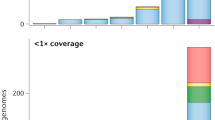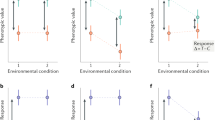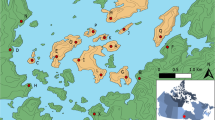Abstract
Peromyscus spp. are the most abundant native North American mammals. They have gained popularity as research animals in the last 20 years, and this trend is expected to continue as new research tools, such as whole genome sequences, baseline physiological data and others, become available. Concurrently, advances have been made in the recommendations for the care of laboratory animals. The authors provide insight into how the Peromyscus Genetic Stock Center successfully breeds and maintains several stocks of deer mice and related species. This information is beneficial to researchers that plan to include Peromyscus spp. in their research programs.
This is a preview of subscription content, access via your institution
Access options
Subscribe to this journal
We are sorry, but there is no personal subscription option available for your country.
Buy this article
- Purchase on Springer Link
- Instant access to full article PDF
Prices may be subject to local taxes which are calculated during checkout







Similar content being viewed by others
References
Dewey, M.J. & Dawson, W.D. Deer mice: “The Drosophila of North American mammalogy”. Genesis 29, 105–109 (2001).
Dawson, W.D. in Contribuciones Mastozoológicas en Homenaje a Bernardo Villa. (eds. Sanchez-Cordero, V. & Medellin, R.A.) 145–156 (UNAM, Mexico City, Mexico, 2005).
Labinskyy, N. et al. Longevity is associated with increased vascular resistance to high glucose-induced oxidative stress and inflammatory gene expression in Peromyscus leucopus. Am. J. Physiol. Heart Circ. Physiol. 296, H946–H956 (2009).
Sacher, G.A. & Hart, R.W. Longevity, aging and comparative cellular and molecular biology of the house mouse, Mus musculus, and the white-footed mouse, Peromyscus leucopus. Birth Defects Orig. Artic. Ser. 14, 71–96 (1978).
Sumner, F.B. Longevity in the Peromyscus. J. Mammal. 3, 70–81 (1922).
Joyner, C.P., Myrick, L.C., Crossland, J.P. & Dawson, W.D. Deer mice as laboratory animals. ILAR J. 39, 322–330 (1998).
Dawson, W.D. (ed.) A brief history of the Peromyscus Genetic Stock Center. Peromyscus Newsletter 39, 11–16 (2005).
Aguero-Rosenfeld, M.E. Laboratory aspects of tick-borne diseases: lyme, human granulocytic ehrlichiosis and babesiosis. Mt. Sinai J. Med. 70, 197–206 (2003).
Centers for Disease Control and Prevention. Facts About Hantaviruses: What You Need to Know to Prevent the Disease Hantavirus Pulmonary Syndrome (HPS). (http://www.cdc.gov/hantavirus/pdf/hps_brochure.pdf)
Kenney-Hunt, J. et al. A genetic map of Peromyscus with chromosomal assignment of linkage groups (a Peromyscus genetic map). Mamm. Genome. doi:10.1007/s00335-014-9500-8 (published online 21 January 2014).
Kapoor, A. et al. Identification of rodent homologs of hepatitis C virus and pegiviruses. mBio 4, e00216–13 (2013).
McNair, G.T. The deer mouse, Peromyscus, a valuable laboratory mammal. J. Mammal. 12, 48–52 (1931).
Institute for Laboratory Animal Research. Guide for the Care and Use of Laboratory Animals 8th edn. (National Academies Press, Washington, DC, 2011).
Reinhardt, V. (ed.) Comfortable Quarters for Laboratory Animals 9th edn. (Animal Welfare Institute, Washington, DC, 2002).
Powell, S.B., Newman, H.A., McDonald, T.A., Bugenhagen, P. & Lewis, M.H. Development of spontaneous stereotyped behavior in deer mice: effects of early and late exposure to a more complex environment. Dev. Psychobiol. 37, 100–108 (2000).
Steyermark, A.C. & Mueller, P.J. Cage size affects feeding and energetics of captive rodents. Physiol. Biochem. Zool. 75, 209–213 (2002).
Crossland, J. & Lewandowski, A. Peromyscus: a fascinating laboratory animal model. Tech Talk 11, 1–2 (2006).
Walton, M.A. A Hermit's Wild Friends: or, Eighteen Years in the Woods (D. Estes, Boston, MA, 1903).
Layne, J.N. Postnatal development and growth of Peromyscus floridanus. Growth 30, 23–45 (1966).
Svihla, A. A Comparative Life History Study of the Mice of the Genus Peromyscus (The University of Michigan Press, Ann Arbor, MI, 1932).
Trainor, B.C., Martin, L.B., Greiwe, K.M., Kuhlman, J.R. & Nelson, R.J. Social and photoperiod effects on reproduction in five species of Peromyscus. Gen. Comp. Endocrinol. 148, 252–259 (2006).
Rollin, B.E. Animal research: a moral science. Talking Point on the use of animals in scientific research. EMBO Rep. 8, 521–525 (2007).
Dawson, W.D., Lake, C.E. & Schumpert, S.S. Inheritance of burrow building in Peromyscus. Behav. Genet. 18, 371–382 (1988).
Wolff, J.O. in Advances in the Study of Peromyscus (Rodentia) (eds. Kirkland, G.L. Jr. & Layne, J.N.) 271–291 (Texas Tech University Press, Lubbock, TX, 1989).
Turner, C.A. & Lewis, M.H. Environmental enrichment: effects on stereotyped behavior and neurotrophin levels. Physiol. Behav. 80, 259–266 (2003).
Dice, L.R. & Hoslett, S.A. Variation in the spontaneous activity of Peromyscus as shown by recording wheels. Contrib. Lab. Vert. Biol., Univ. Michigan 47, 1–18 (1950).
Acknowledgements
We thank the National Science Foundation, the US National Institutes of Health and University of South Carolina for providing support to PGSC. We thank the members of the University of South Carolina Animal Resources Facility, especially Patricia Conn, Bonnie French, Warren Hall, Julie Jackson, Nikki Schmidt, Ginger Peters and Pam Rudd, for their excellent care of the animals. We also thank Frances Lee for her assistance with the photographs.
Author information
Authors and Affiliations
Corresponding author
Ethics declarations
Competing interests
The authors declare no competing financial interests.
Rights and permissions
About this article
Cite this article
Crossland, J., Dewey, M., Barlow, S. et al. Caring for Peromyscus spp. in research environments. Lab Anim 43, 162–166 (2014). https://doi.org/10.1038/laban.504
Received:
Accepted:
Published:
Issue Date:
DOI: https://doi.org/10.1038/laban.504



